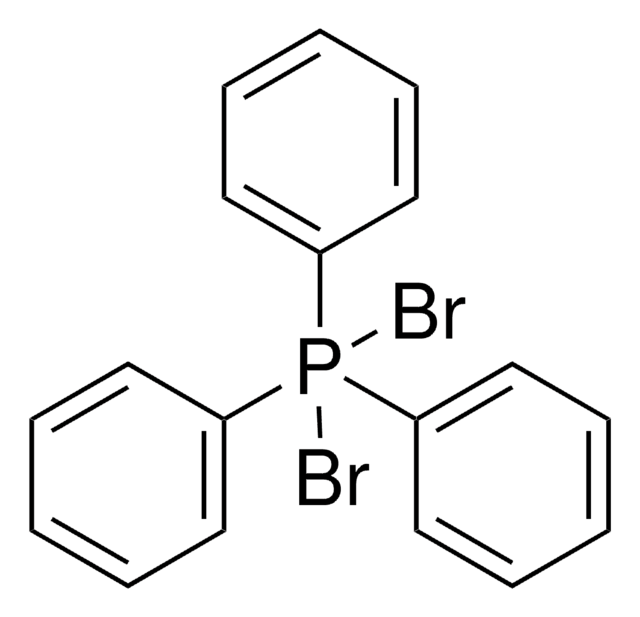378755
Dichlorotriphenylphosphorane
95%
Sinonimo/i:
Triphenylphosphine dichloride
About This Item
Prodotti consigliati
Saggio
95%
Forma fisica
solid
Punto di fusione
85 °C (dec.) (lit.)
Stringa SMILE
ClP(Cl)(c1ccccc1)(c2ccccc2)c3ccccc3
InChI
1S/C18H15Cl2P/c19-21(20,16-10-4-1-5-11-16,17-12-6-2-7-13-17)18-14-8-3-9-15-18/h1-15H
ASWXNYNXAOQCCD-UHFFFAOYSA-N
Cerchi prodotti simili? Visita Guida al confronto tra prodotti
Categorie correlate
Descrizione generale
Applicazioni
- tertiary benzanilide derivatives
- N-phosphodipeptides
- dialkyl phosphorochloridites based on the reaction of trialkyl phosphites
- naphthalene ring-based calix[3]amide, via reaction with 6-amino-2-naphthoic acid
- C2v-symmetrical cyclic tetramers of aromatic amides
Avvertenze
Danger
Indicazioni di pericolo
Classi di pericolo
Carc. 1B - Eye Dam. 1 - Flam. Sol. 2 - Skin Corr. 1B
Codice della classe di stoccaggio
4.1B - Flammable solid hazardous materials
Classe di pericolosità dell'acqua (WGK)
WGK 3
Punto d’infiammabilità (°F)
68.0 °F - closed cup
Punto d’infiammabilità (°C)
20 °C - closed cup
Elenchi normativi
Forniamo informazioni su eventuali restrizioni prevalentemente per i prodotti chimici. Per altre tipologie di prodotto siamo in grado di fornire soltanto informazioni limitate. Nessuna segnalazione significa che nessuno dei componenti è citato in un elenco. È dovere dell’utilizzatore assicurarsi che il prodotto venga impiegato in maniera sicura e a norme di legge.
EU REACH SVHC Candidate List
EU REACH Annex XVII (Restriction List)
EU REACH Annex XIV (Authorisation List)
Certificati d'analisi (COA)
Cerca il Certificati d'analisi (COA) digitando il numero di lotto/batch corrispondente. I numeri di lotto o di batch sono stampati sull'etichetta dei prodotti dopo la parola ‘Lotto’ o ‘Batch’.
Possiedi già questo prodotto?
I documenti relativi ai prodotti acquistati recentemente sono disponibili nell’Archivio dei documenti.
I clienti hanno visto anche
Il team dei nostri ricercatori vanta grande esperienza in tutte le aree della ricerca quali Life Science, scienza dei materiali, sintesi chimica, cromatografia, discipline analitiche, ecc..
Contatta l'Assistenza Tecnica.



















